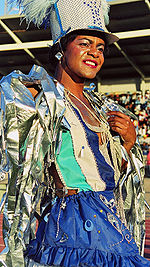- Kaapse Klopse
-
 A "Coon" in classic minstrel style struts his stuff at the Greenpoint Stadium in Cape Town, South Africa - 2001A troupe passes on Darling Street during the January 2011 festival
A "Coon" in classic minstrel style struts his stuff at the Greenpoint Stadium in Cape Town, South Africa - 2001A troupe passes on Darling Street during the January 2011 festivalThe Kaapse Klopse (or simply Klopse) is a minstrel festival that takes place annually on January 2, in Cape Town, South Africa. As many as 13,000 minstrels take to the streets garbed in bright colours, either carrying colourful umbrellas or playing an array of musical instruments. The minstrels are grouped into klopse ("clubs" in Cape Dutch, but more accurately translated as troupes in English). Participants are typically from Afrikaans-speaking working class "coloured" families who have preserved the custom since the mid-19th century.
Although it is called the Coon Carnival by Capetonians, local authorities have renamed the festival the Cape Town Minstrel Carnival as foreign tourists find the term "coon" derogatory.[citation needed]
Contents
History
One story goes that the carnival was inspired by a group of African-American minstrels who docked in Cape Town in the late 1800s and entertained the sailors with their spontaneous musical performances. The popular song Daar kom die Alibama (There comes the Alabama) refers to the ship that is believed to have brought them.[1] Another story goes that the travelling minstrels were actually white and painted their faces black – hence the painted faces seen today.[citation needed]
Troupe organisation
The majority of the troupes (169) are represented by the Kaapse Karnaval ("Cape Carnival") Association. In addition, two breakaway organisations (the Kaapse Klopse Karnaval Association and the Mitchell's Plain Youth Development Minstrel Board) represent a minority of troupes.
The carnival today
The festival begins on New Year's Day and continues into January. Festivities include street parades with singing and dancing, costume competitions and marches through the streets. While many troupes now are supported by corporate sponsors, many refuse and remain sticklers for tradition. The 2005 carnival was nearly cancelled due to an alleged lack of funding, while the 2006 carnival was officially called off for the same reason.[2][3] However, the troupe organisations subsequently decided to go ahead with the parade despite continued unhappiness over funding, and the festivities were opened by Western Cape premier Ebrahim Rasool on 2 January 2006.[4]
References
- ^ People's Post 2010-11-23, p2
- ^ Cape Times
- ^ News - South Africa: Minstrels set to scrap Cape parade (Page 1 of 2)
- ^ Cape Times
External links
- Cape Town Minstrel Festival 2008
- Tweede Nuwe Jaar 2001 A foreign scholar joins the Lentegeur Entertainers.
- Yankee Minstrel First white American in the Carnival
- Cape Town Minstrel Carnival FAQ Answers to frequently asked questions about the Cape Town Minstrel Carnival
Categories:- History of Cape Town
- Festivals in South Africa
Wikimedia Foundation. 2010.

